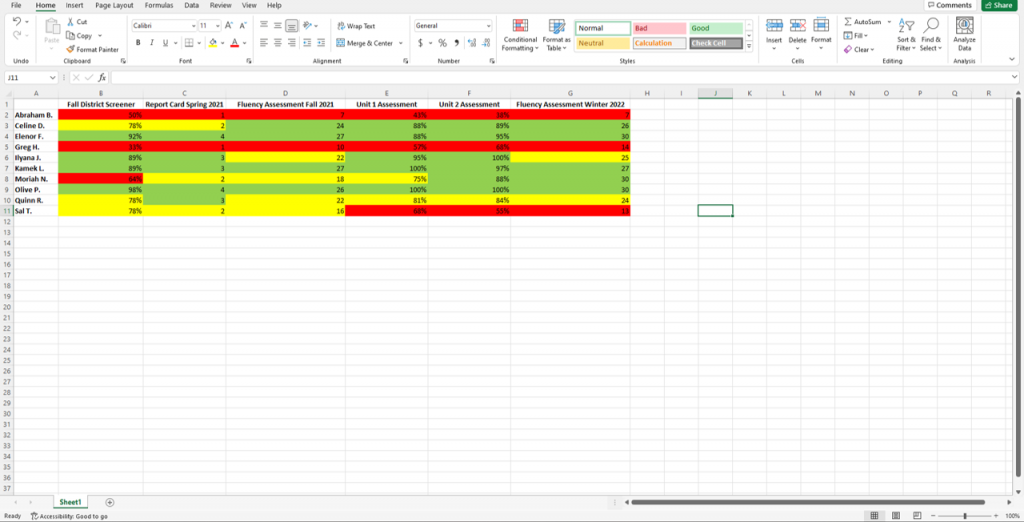Not too long ago I asked teachers what the biggest barriers were to their math intervention strategy. One of the answers that came up most often was around the topic of needing a strong math intervention assessment.

I was fortunate enough to work in a district that did provide us with a variety of assessments that I could have never afforded personally, and yet, I don’t believe that the success of any of my students could be attributed directly to those assessments.
Assessments don’t teach students.
Assessments inform instruction.
So let’s talk about a math intervention assessment strategy that works and will inform your instruction regardless of whether or not your district is providing you with the holy grail of intervention assessments or not!
Start With the Big Picture
If you are a classroom teacher this means looking at your class as a whole. If you are an interventionist, this means looking at the grade level as a whole. Your goal is to identify which of your students are not meeting, working towards, at, and even above grade level.
The best way to gain this big-picture look at your population is to gather multiple data points for each of your students and put them together in one spreadsheet. Using multiple data points rather than relying solely on an individual math intervention assessment ensures that you can get the most complete and fair picture possible of each student.
Possible data points might include:
- A commercially produced screening assessment
- A computational fluency assessment
- State test results from the previous grade level
- Most recent report card grades (can be from the previous grade level!)
- Teacher input (simply ask, is this student not meeting, working toward, at or above grade level on a daily basis)
- Unit assessment data
- etc.

You likely will not have all of these data points and none of these individual data points are perfect in terms of their ability to present whether or not a student has a need for math intervention. That being said, when you take multiple data points together in one spreadsheet and look at the big picture it can help to illuminate the students who are consistently in the zone of “not meeting” math standards.
Determine What YOU Want to Know From Your Math Intervention Assessment
Once your students have been identified, your next step is to determine what information YOU need in order to meet your goals for your student.
- Do you need a fact fluency assessment strategy? Search for a tool, create a tool yourself or use the tool at the end of this blog post to assess your students and their fact fluency. This is likely a skill you will want to assess and track over time looking for increased speed and accuracy over time.
- Do you want to prove growth or decide where to go next within a skill for your students? Consider a pre and post assessment at the beginning and end of each of your intervention units with daily “tickets out the door” along the way. This is a quick and easy way to show that your students grew (or did not grow) based on specific and targeted instruction around a topic. Not sure where to start choosing units? This planning guide or this intervention checklist may help!)
- Do you want to prove long-term growth in your students? Continue adding to your “Big Picture” spreadsheet throughout the year. Add unit assessment data, report card data and fluency assessment data along with any district provided/mandated assessments.
Look at the data set below.- Positive Growth Example: If you were working in a small group setting with Moriah, for example, you can show that early in the school year she was in the not meeting/working towards zone across multiple data points. As the year moved on, both her scores on classroom assessments and fluency assessments show significant growth. She’s now consistently performing at grade level work.
- Need for Intervention Example: Consider that Sal, initially was not picked up in an intervention group because he was in the “working towards” zone on multiple assessments. As the year progressed he began to show consistent need. This data would be useful towards proving that Sal may need additional intervention in order to be successful.
- More Support Needed Example: If, as an interventionist, you picked Abraham up at the beginning of the year and worked with him in an intensive small group, you could use this “big picture” spreadsheet to advocate for additional supports for Abraham. Other members of the group such as Greg and Moriah are slowly showing some growth toward grade level, Abraham’s scores show that he is not making any growth and is actually moving further away from the benchmark.

Organize This Data Into A Spreadsheet
For each assessment you give, enter your final assessment score into a spreadsheet. Determine what score might be considered “On Target” “Working Towards” and “Not Meeting” for that assessment.
Don’t get too caught up in the scores you assign to each of these groups. Go with your gut! The purpose of this spreadsheet is to make your data visual so that it “pops” for YOU.
Color code your results so that any “On Target” score is colored green, “Working towards” is colored yellow and “Not Meeting” is colored red.
Why Color Code Your Data?
When you look across your spreadsheet you will quickly see a picture of your students over time. Did their data begin consistently red and move towards more yellow and green data points? Great! Keep doing what you are doing!
Do you see students who have been red on all data points while the rest of your spreadsheet shows students making progress and growing in their understanding? It might be time to talk to your colleagues and possibly even bring that student to your school’s academic problem-solving team.
When you are feeling frustrated that you don’t have *the perfect* math intervention assessment in place, remember, ANY individual tool will have benefits and drawbacks and no individual tool is going to paint the perfect picture of your students.
Take multiple data points and consider them as a bigger picture whenever possible and remember YOUR purpose in giving any specific assessment. Data is meant to inform your instruction and to provide you with the information that you need about your students.




